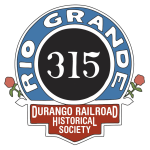
REEFER HISTORY
The need to transport perishable goods across distances gave rise to refrigerated cars, also known as ‘reefers’ but not before the D&RG tried ventilated cars. Built in 1879, they were basically a boxcar with stock car doors but they were not enough to handle the traffic so they were rebuilt with ice hatches and bunkers at each end. Other similar cars followed until finally in 1908 the D&RG built 50 new 30 ft., 20-ton refrigerator cars at their Burnham shops in Denver. Numbered 32-81, they too had ice bunkers at each end but ran on trucks with an extended 4’8” wheel base to accommodate inside brakes; inside brakes were needed to prevent water dripping from the ice bunkers and freezing on the brakes. The inside length of the car was just under 24ft and the walls and doors were heavily insulated with burlap and other materials. In 1926 all the cars, except #79, which had been wrecked on the Ames Slide on the Rio Grande Southern, were rebuilt with Murphy roofs, larger ice hatches and altered needle beams. Also replaced were the draft gear, brake cylinders, icebox bulkhead, insulation, flooring, pots and side braces, and truck and bolster bearings.
The D&RGW built a further twenty reefers in 1924 and 1926. They had an increased carrying capacity of 25-tons and were 40ft. long but still required ‘icing’. The D&RGW narrow gauge never graduated to mechanically refrigerated cars and their reefer service ceased in 1958 when the last of the cars was retired.
Reefers carried perishable goods such as meat, fruit and vegetables from markets to towns for wider distribution than had ever been possible. Icehouses, such as those in Durango and Ridgway, were maintained specifically to replenish the iceboxes so that isolated towns could get a regular supply of otherwise perishable food. But they also had more unusual uses too. In the winter some were used to insulate dynamite from the cold so that mining in towns like Silverton could continue. And during the really cold weather they were fitted with heaters to prevent goods from freezing.
Discover more about how reefers were essential to SW Colorado. Watch Duane Danielson’s presentation on YouTube HERE The lecture was given at Fort Lewis College, Durango, CO.